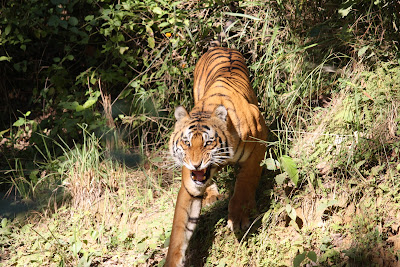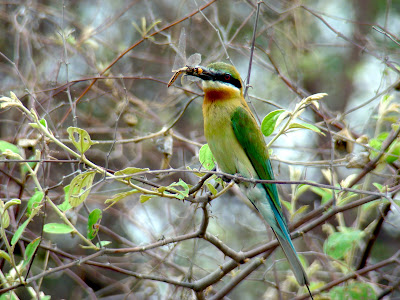Place - Jim's Jungle Retreat
Quarterly Update - Imran Khan
One of the heaviest monsoons in recent memory set us up for a severe winter. While it can be very cold during safaris, winter probably is the best time to view Corbett Tiger Reserve: its multitudinous landscape of varying habitats, floral and faunal features, offers itself in a spectacular way, with incredible wildlife sightings of the tiger, leopard, elephants and hundreds of birds and butterflies. The late September monsoon showers were excessive this
year, unfortunately, and caused severe damage to the road networks inside the park.
year, unfortunately, and caused severe damage to the road networks inside the park.
Several roads in Bijrani and Dhikala tourism zones which had washed away are now being repaired, slowly returning the entire tourism zone to its pre-monsoon status. The water level of Ramganga reservoir in Dhikala tourism zone also is receding now, while the devastated Sambhar Road is finally returning to its preeminent status as a prime ecotone area between river and forest for large mammal and raptor (birds of prey) sighting.
There has been a salubrious effect of the late monsoons however. In the drier regions of the park, several of the water holes continue to retain water, thereby playing a vital role in the early pairing of tigers in Bijrani as well as Jhirna. This pairing movement of the male and female has led to an increase in tiger sightings, as a pair of animals is more easily exposed by the ever-vigilant prey that give alarm calls to warn others.
TIGERS ABOUND, BEARS SHOW UP
In Jhirna, a female with three growing cubs has been active and regularly sighted. In fact, we have had incredible tiger sightings at either the Bijrani or Jhirna zone over the last two months, with nearly 85% of the retreat's visitors having seen a tiger or two!
During interactions with the Corbett research team responsible for laying camera traps to establish the tiger count here, I was informed there are around 20-25 cubs with their mothers in Corbett today, which is an incredible adult-to-cub sex ratio for any single reserve in the entire distribution range of the tigers!
 |
| Tiger, Bijrani Photo: Majid Hussain |
Jhirna over the years has attained the distinction of harboring a resident elephant population and nearly every safari has sighted these gentle giants, with many baby elephants now part of the larger matriarch-led group.
 | |
| Tusker at Jhirna Photo: Daleep Akoi |
Corbett's bird life is especially worthy of spending time here now. The park is a cacophony of birdsong. Thanks to the fruiting of various ficus species such as Ficus glomerata, Ficus elastica and Schleichera Oleosa or Kusum one can see several mixed flocks of Minivets, Grey-headed canary flycatchers, Bronzed-winged drongos, Verditer flycatchers, Grey-capped pygmy woodpecker, Common woodshrike, both species of Nuthatches and the Grey-hooded warblers.
 |
| Blue-tailed bee-eater, Merops philippinus. Photo: Daleep Akoi |
Chestnut-headed bee-eaters and Blue-tailed bee-eaters have gone back to their parent habitats while the Blue-bearded bee-eaters have arrived for breeding. The blue-bearded bee-eater is one of several top forest canopy species, along with two species of leafbirds, while the Oriental pied hornbill and Great hornbill have started “gackling” their casks, indicating the onset of breeding. One can see flocks of them on safaris in Jhirna.
Mid-canopied birds such as orioles and woodpeckers have also started breeding. All three species of orioles including the Corbett-specific Maroon oriole are heard on the jeep as well as on walking safaris. The three species of the flameback woodpecker and other mid-sized woodpeckers have paired for breeding too. Constant vocalisation and fluttering in the trees will point their presence to you.
Mid-canopied birds such as orioles and woodpeckers have also started breeding. All three species of orioles including the Corbett-specific Maroon oriole are heard on the jeep as well as on walking safaris. The three species of the flameback woodpecker and other mid-sized woodpeckers have paired for breeding too. Constant vocalisation and fluttering in the trees will point their presence to you.
One of our guests has captured a picture of a Black stork perching on a tree, unique, as they are usually seen on riverbeds. The Ibisbill has been sighted regularly along the Kosi river on the eastern periphery and this season there have been two individuals roaming the river bed, unlike the past where only a solitary bird was sighted. Among the raptors, the Pallas’s Fishing eagle and the Changeable hawk eagles have been seen with chicks.
Meantime, I was made privy to an interesting sighting by a regular visitor to Corbett: It is very unusual for a Pied kingfisher to make its nest at this time of the year, but surprisingly there was not one but two adults sighted, fluttering about building a nest close to Dhangarhi Sot around 10 days ago. To our greater surprise, these nests weren't being built to rear more young, but to teach existing youngsters the art of building a perfect nest!
Meantime, I was made privy to an interesting sighting by a regular visitor to Corbett: It is very unusual for a Pied kingfisher to make its nest at this time of the year, but surprisingly there was not one but two adults sighted, fluttering about building a nest close to Dhangarhi Sot around 10 days ago. To our greater surprise, these nests weren't being built to rear more young, but to teach existing youngsters the art of building a perfect nest!

No comments:
Post a Comment